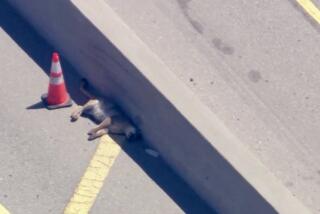Trying to Outwit Foolish Drivers
Gates with flashing red lights and clanging bells don’t deter them. TV ads with grisly images of cars being crushed like tin cans don’t deter them. Even a 350-ton train barreling down at 70 mph doesn’t deter them.
Some motorists are determined to try to beat out trains at crossings, even if it could cost them their lives.
Now, the answer to human stupidity may lie in intelligent machines.
Transportation officials--working with defense contractors looking for peacetime uses for Cold War technology--are experimenting with high-tech barriers to prevent accidents at crossings.
Possible solutions include:
* Nets--sort of like the ones on tennis courts but considerably stronger--that are lowered in front of cars when a train approaches.
* Six-foot-high barriers that pop up from an underground vault in the roadway to block off the tracks.
* Sensors in the crossing that warn train operators to stop when a car is blocking the way.
“We’re going to try to prevent you from killing yourself,” said Stephen Szegedy, project manager for the Connecticut Department of Transportation, which is testing the sensors.
The safety measures are important because the Los Angeles region is undergoing a rail renaissance.
Twenty-nine people have died in collisions on the Los Angeles-to-Long Beach Blue Line since it began operation in 1990. Since Metrolink launched its service in 1992, crashes have led to 34 deaths--including that of a 2-year-old passenger in a car.
But those numbers understate the number of life-and-death rolls of the dice that occur daily. Cars have been spotted racing under descending gates as often as once every few hours.
*
Lt. Anthony Torres, watch commander at the sheriff’s Metrolink Bureau, has heard excuses ranging from “I’m late for school [or work] and didn’t want to wait for a train” to “I didn’t know the train was going that fast.” One man said he was so busy looking in the rear-view mirror while combing his hair that he crashed through the gate into the side of a Metrolink train. He later died, Torres said.
The collisions also cost taxpayers. Metrolink officials report that their trains have sustained more than $1 million in damage. They have recovered about $70,000 from insurance companies of motorists at fault.
The Metropolitan Transportation Authority has been installing cameras--in bulletproof cases--along the Blue Line to catch drivers who pull around lowered gates. Photos are taken of the license plates and violators receive $104 tickets in the mail. About 1,400 citations have been issued since September.
*
In Illinois, a study is underway on the net that would catch cars. As gates lower, the 4-foot-high, 48-foot-long net also would come down.
The barrier is based on the concept used on aircraft carriers to stop jets in an emergency.
“We can stop a 2,500-pound car, and we can also stop an 80,000-pound tractor-trailer,” said Cary Corkin, vice president of Entwistle Co., the Massachusetts company that manufactures the system.
Also under study are the six-foot-high barriers that pop up from an underground vault.
The barrier’s crash cushions--painted in the international hazard colors of black and yellow stripes--are being developed by Consolidated Launcher Technology, a Virginia-based defense contractor. “The barrier, upon impact, collapses backward like an accordion,” said project manager Dan Lynch.
One possible problem with barriers is: What happens to a motorist who is trapped on the tracks between the barriers?
Sensors can be put in the roadway that can detect when a car is trapped. But as the barrier is lifted to let out the trapped car, new cars might try to rush across the tracks ahead of a train. Corkin said a motorist trapped between nets should be safe because the nets would be set back 100 feet from the tracks.
Perhaps the solution can be found in a system that will soon be tested in Connecticut. Sensors in the pavement at crossings and computers in locomotives would signal the engineers of trouble ahead, improving the chances that trains could stop in time.
The system also uses four gates instead of the usual two. Currently, motorists pull around the lowered gate. This new system would add a gate on each side to block the entire road.
Although the new technology is promising, the best way to prevent collisions at crossings remains common sense.
People need to remember that a passenger train traveling 79 mph takes half a mile to stop, even after the emergency brake is applied.
More to Read
Sign up for Essential California
The most important California stories and recommendations in your inbox every morning.
You may occasionally receive promotional content from the Los Angeles Times.











